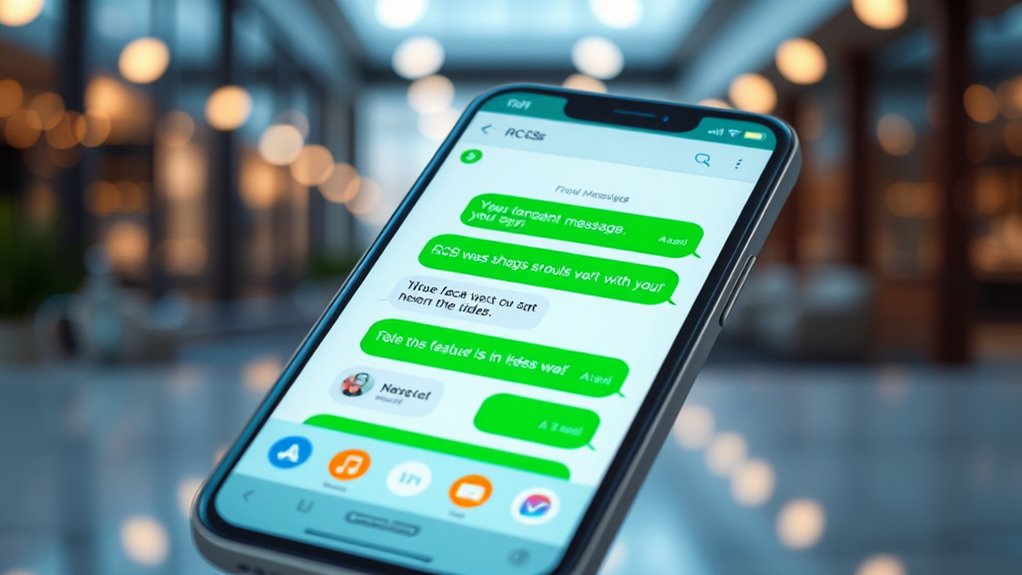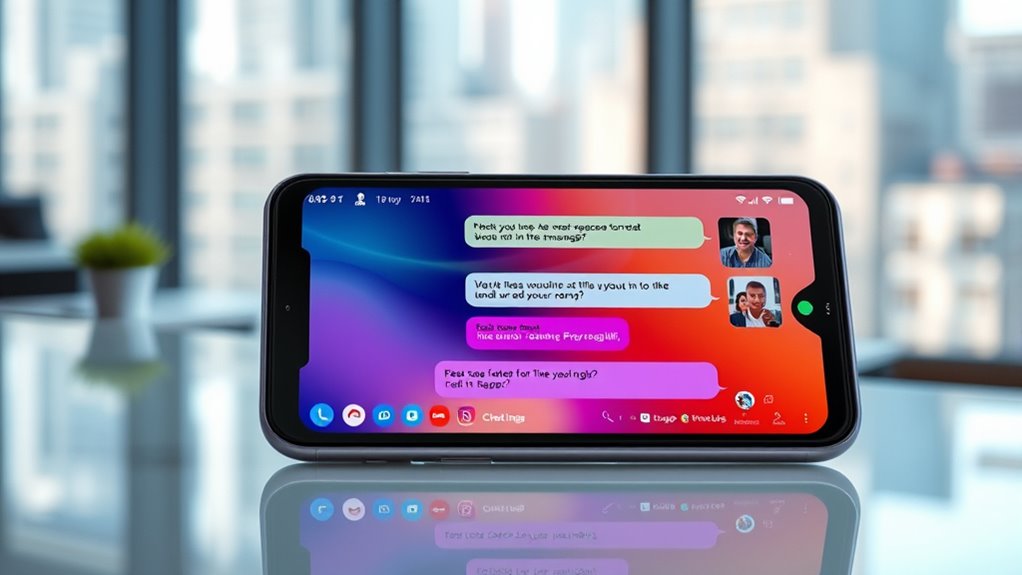RCS messaging offers features like group chats, multimedia sharing, read receipts, high-res photo sharing, and typing indicators to make your conversations richer and more transparent. It helps you coordinate easily with multiple contacts at once and confirms when messages are viewed. However, some functions depend on your device, carrier, and internet connection, which can cause limitations or inconsistencies. To discover detailed insights on how these features work and their restrictions, keep exploring further.
Key Takeaways
- RCS supports group chats, multimedia sharing, read receipts, high-resolution photos, and typing indicators for richer communication.
- It enables real-time conversations, centralized messaging, and improved collaboration for personal and professional use.
- Read receipts provide transparency by showing who has viewed messages within individual and group chats.
- Limitations include inconsistent device or carrier support, dependency on internet connectivity, and potential fallback to SMS.
- Security features aim to protect user data, but compatibility and network issues can affect overall functionality.

RCS Messaging, or Rich Communication Services, is transforming the way you send and receive messages on your smartphone. It offers a more dynamic and interactive messaging experience compared to traditional SMS. One of the standout features is the ability to create group chats, where you can chat with multiple contacts at once. This makes staying in touch with friends, family, or colleagues much easier and more organized. When you’re part of a group chat, you can send messages that everyone in the group can see and respond to, fostering real-time conversations without switching between different threads. Group chats also support sharing multimedia files like photos, videos, and even location updates, making them versatile tools for both personal and professional communication.
Another key feature of RCS messaging is read receipts, which let you see when your messages have been opened and viewed by the recipient. This feature helps you stay informed about whether your message has reached the other person and if they’ve taken a look at it. It’s particularly useful in professional settings where confirming receipt can be important, or in personal conversations when you’re enthusiastic to know if someone received your message. Read receipts also work in group chats, so you can see who has read specific messages, adding a layer of transparency to your conversations. This can help manage expectations, especially when coordinating plans or making decisions, as you’ll instantly know who’s aware of the latest updates.
Beyond group chats and read receipts, RCS introduces other enhancements like high-resolution photo sharing, typing indicators, and the ability to send larger files. These features elevate your messaging experience by making conversations more visual and interactive. However, it’s important to understand the limits of RCS as well. Not all devices or carriers support RCS fully, so some features might not be available to everyone. You might find that read receipts or group chat functionalities are inconsistent if your network or device isn’t compatible. Plus, RCS still relies on internet connectivity, so if you’re in an area with poor data service, the experience can be disrupted or revert to traditional SMS, reducing some of its advantages. Additionally, AI security measures are increasingly integrated into messaging platforms to safeguard user data and prevent cyber threats, making RCS a more secure communication method.
Frequently Asked Questions
Does RCS Messaging Work Internationally?
Yes, RCS messaging can work internationally, but its effectiveness depends on international compatibility and cross-platform support. If your carrier and recipient’s carrier support RCS, you’ll enjoy features like read receipts and high-quality media worldwide. However, not all countries or networks fully support RCS, so double-check with your provider. Keep in mind, cross-platform support varies, and some devices or regions might still rely on traditional SMS or other messaging apps.
Can I Use RCS Without an Android Device?
You can’t use RCS messaging without an Android device because it relies on carrier restrictions and native device support. RCS is primarily designed for Android phones and isn’t cross-platform compatible with iOS or other operating systems. To enjoy RCS features, your carrier must support it, and your device needs to be compatible. Without an Android device, you’ll need to stick with traditional SMS or switch to apps like WhatsApp for messaging.
How Secure Is RCS Messaging?
Picture a secure vault versus an open mailbox—that’s RCS messaging for you. It offers end-to-end encryption, so your messages are protected from prying eyes. However, privacy concerns remain because RCS isn’t as universally secure as traditional messaging apps like Signal or WhatsApp. While it’s reasonably safe for everyday use, you should stay cautious with sensitive information, understanding that some vulnerabilities still exist in RCS’s security infrastructure.
Is RCS Compatible With All Carriers?
RCS messaging isn’t compatible with all carriers, as carrier compatibility varies. You need to check if your carrier supports RCS and whether your device meets the necessary requirements. Some carriers have fully adopted RCS, while others are still rolling it out or haven’t adopted it at all. To guarantee smooth messaging, verify your carrier’s support and ensure your device is updated with the latest software and features.
Can I Send Multimedia Messages via RCS?
Yes, you can send multimedia messages via RCS, allowing you to share photos, videos, and other media easily. RCS supports multimedia sharing, making conversations more dynamic. Keep in mind, there’s a message size limit—usually around 100 MB—so very large files might not go through. Overall, RCS enhances your messaging experience by enabling richer, more interactive communication with friends and family.
Conclusion
In brief, RCS messaging packs powerful features like read receipts and high-res images, but it’s not without limits—file size caps and compatibility issues still linger. While it’s a leap forward, it’s not quite the magic carpet of modern messaging. Think of it like the Pony Express—reliable for its time, but now outpaced by the instant, seamless flow of today’s tech. Keep these limits in mind, and you’ll stay ahead in the messaging game.









